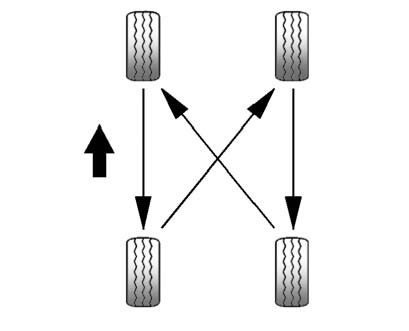Tire Rotation
Tires should be rotated every 12 000 km (7,500 mi). See Maintenance Schedule .
Tires are rotated to achieve a uniform wear for all tires. The first rotation is the most important.
Any time unusual wear is noticed, rotate the tires as soon as possible and check the wheel alignment. Also check for damaged tires or wheels. See When It Is Time for New Tires and Wheel Replacement .

Use this rotation pattern when rotating the tires.
Do not include the compact spare tire in the tire rotation.
Adjust the front and rear tires to the recommended inflation pressure on the Tire and Loading Information label after the tires have been rotated.
See Tire Pressure and Vehicle Load Limits .
Reset the Tire Pressure Monitor System. See Tire Pressure Monitor Operation .
Check that all wheel nuts are properly tightened. See“Wheel Nut Torque” under Capacities and Specifications .
![]() WARNING
WARNING
Rust or dirt on a wheel, or on the parts to which it is fastened, can make wheel nuts become loose after time. The wheel could come off and cause an accident. When changing a wheel, remove any rust or dirt from places where the wheel attaches to the vehicle.
In an emergency, a cloth or a paper towel can be used; however, use a scraper or wire brush later to remove all rust or dirt.
Lightly coat the center of the wheel hub with wheel bearing grease after a wheel change or tire rotation to prevent corrosion or rust build-up. Do not get grease on the flat wheel mounting surface or on the wheel nuts or bolts.
See also:
Halogen Bulbs
WARNING
Halogen bulbs have pressurized gas inside and can burst if you drop or scratch the bulb. You or others could be injured. Be sure to read and follow the instructions on the bulb package. ...
Trailer Towing (Except eAssist)
Before pulling a trailer, there are
three important considerations that
have to do with weight:
• The weight of the trailer.
• The weight of the trailer tongue.
• The total weight on your ...
Privacy
The complete OnStar Privacy
Statement may be found at
www.onstar.com. Privacy-sensitive
users of wireless communications
are cautioned that the privacy of any
information sent via wireless c ...


